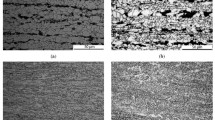Conclusions
-
1.
An increase of the modulus of rupture of BFMS under dynamic loading can be attained by reducing the strength of martensite (its carbon content) and comminuting its sections, which is achieved by reducing the concentration of carbon in the steel, by hardening at a higher temperature of the biphase region, and by preparing the corresponding initial structure.
-
2.
Comminution of the ferrite grain in BFMS and reduction of the distortions of the α-lattice by interstitial atoms by reducing the cooling rate, the introduction of carbonitride forming elements, or the use of concluding low tempering (200–250°C) make it possible, with greater strength of the BFMS, to ensure better fracture characteristics than in steels with the same composition but with ferritic-pearlitic structure.
-
3.
A characteristic trait of BFMS is the predominant crack development in one of the phases: the sections of ductile failure on the surface of impact test specimens tested in the range of the brittle-ductile transition belong basically to the martensitic phase; the fatigue crack, especially in the region of small ΔK, develops predominantly in the ferritic matrix.
Similar content being viewed by others
Literature cited
S. A. Golovanenko and N. M. Fonshtein, Biphase Low Alloy Steels [in Russian], Metallurgiya, Moscow (1986).
C. R. Magee and R. G. Davies, "Automotive sheet steels for the 80s," in: Alloys of 80s, Proc. of It. Symp. IMS-AIME, Paper 3, Ann Arbor (1980), p. 142.
B. G. Sazonov, "The effect of secondary quenching from the intercritical range on the disposition of steel to reversible brittleness," Metalloved. Term. Obrab. Met., No. 4, 30–34 (1957).
A. M. Polyakova and V. D. Sadovskii, "‘Intercritical’ hardening of structural steels," Metalloved. Term. Obrab. Met., No. 1, 5–8 (1970).
V. G. Laz'ko, V. E. Laz'ko, and B. M. Ovsyannikov, "Deformation resistance and modulus of rupture of structural steels heat-treated from the intercritical temperature range," Izd. Akad. Nauk SSSR, Met., No. 1, 136–143 (1981).
A. G. Vasil'eva, T. V. Gulyaeva, and B. G. Sazonov, "The effect of the initial structure and heating rate on the properties of steel after hardening from the intercritical range," Metalloved. Term. Obrab. Met., No. 5, 52–55 (1981).
A. N. Bortsov and N. M. Fonshtein, "Distribution of deformations among the phases of ferritic-martensitic steels," Fiz. Met. Metalloved.,61, No. 2, 289–296 (1986).
A. S. Shein and T. A. Lebedev, "The structure and impact toughness of steel hardened from the critical interval," in: Heat Treatment of Metals, [in Russian], Mashgiz, Moscow, pp. 166–177.
N. M. Fonshtein, "Heat treatment for obtaining the stipulated ferritic-martensitic structure of steel," Metalloved. Term. Obrab. Met., No. 8, 46–50 (1985).
B. M. Bronfin, N. M. Fonshtein, S. A. Istomin, et al., "Dispersion strengthening and resistance to brittle failure of low alloy steels with vanadium," Izv. Akad. Nauk SSSR, Met., No. 5, 164–170 (1982).
E. Hornbogen, "Microstructure and mechanisms of fracture, in: Strength of Metals and Alloys, 6th Proc. Int. Conf. Vol. 3, Melbourne (1982), pp. 1059–1073.
N. T. Shich, "The relation of microstructure and fracture properties of electron beam melted modified SAE 4620 steels," Met. Trans.,5, No. 5, 1069–1085 (1974).
B. M. Bronfin, A. A. Emel'yanov, A. Z. Shifman, et al., "Special traits of the microstructure and properties of low alloy steel with increased manganese content hardened from the intercritical temperature range," Izv. Akad. Nauk SSSR, Met., No. 5, 113–119 (1984).
A. N. Tkach, N. M. Fonshtein, V. N. Simin'kovich, et al., "Fatigue crack growth in biphase ferritic-martensitic steel," Fiz.-Khim. Mekh. Mater.,20, No. 5, 45–51 (1984).
Additional information
I. P. Bardin Central Research Institute of Ferrous Metallurgy. Translated from Metallovedenie i Termicheskaya Obrabotka Metallov, No. 10, pp. 9–13, October, 1987.
Rights and permissions
About this article
Cite this article
Fonshtein, N.M. Factors determining the modulus of rupture of biphase ferritic-martensitic steels. Met Sci Heat Treat 29, 725–730 (1987). https://doi.org/10.1007/BF00707728
Issue Date:
DOI: https://doi.org/10.1007/BF00707728




